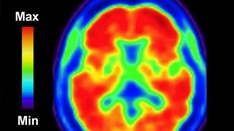LONDON – Knowing the results of amyloid positron-emission tomography (PET) scanning for patients suspected of having mild cognitive impairment (MCI) or dementia led to a significant difference in clinical management, as shown in early results from the Imaging Dementia-Evidence for Amyloid Scanning (IDEAS) study.
Although researchers say they expected that amyloid PET scanning would lead to a change in patient care in 30% of cases, the actual change was twice what was expected, at more than 67%.
"To me, that says we've refined the diagnosis, that people can now have a more correct and more appropriate diagnosis, and they're getting the right treatment," principal investigator Gil D. Rabinovici, MD, professor of neurology, University of California, San Francisco Memory and Aging Center, told Medscape Medical News.

Dr Gil Rabinovici
The results, which were presented here at the Alzheimer's Association International Conference (AAIC) 2017, provide evidence that PET scanning is a useful diagnostic tool that should be covered by insurance, add the investigators.
"Amyloid PET is a game changer," said Dr Rabinovici.
$100 Million Study
PET amyloid ligands were approved in 2012 by the US Food and Drug Administration (FDA). Following a review in 2015, the Centers for Medicare & Medicaid Services determined that there was not enough evidence to prove clinical utility of amyloid PET scans and so decided not to fund in this context. However, they did allocate funding to cover scans for research purposes.
The IDEAS trial is one of the largest of its kind in the United States. Started in 2016, its plan is to recruit 18,500 participants by the end of this year.
The $100 million study includes 674 participating practices across the country, more than 1100 doctors, and almost 400 PET facilities. Of the total budget, $80 million goes toward PET scans.
Study enrollment criteria included being a Medicare recipient, having some signs of cognitive impairment, and being referred by a neurologist, psychiatrist, or geriatrician who spent at least a quarter of practice time assessing cognitive disorders.
"Experts need to see the patient and do their typical standard assessment, which includes an interview not only with the patient but also a family member, cognitive testing, laboratory testing, and MRI," said Dr Rabinovici. "And the doctor needs to think that knowing whether or not patients have amyloid is likely to change their management."
Understanding Nuances
He stressed the importance of physicians "understanding the nuances" of interpreting a PET scan: that having amyloid in the brain is not the same as having Alzheimer's disease (AD).
Although PET scanning provides only one piece of information in the larger clinical context, "it's a very useful piece of data, and it's the most direct biological evidence about the presence or absence of a pathology that's required, essentially, for diagnosis," said Dr Rabinovici.
At the time of patient referral, participating physicians fill out a case report form indicating what their care plan would be without access to results of amyloid imaging. The patient then undergoes scanning, which may or may not lead to a change in the care plan. After 3 months of treatment, the results of treatment are assessed and recorded.
"So we're not looking at intended management; we're looking at actual implemented management," Dr Rabinovici said.
The preliminary results of the study are from 3979 patients between the ages of 65 and 105 years (mean age, about 75 years); 64.4% were diagnosed with MCI, and 35.6% met criteria for dementia.
The analysis showed that post-scan management changed for 67.8% of all patients. Similar changes in management were made for patients with MCI and dementia.
More than three quarters of the patients (78.5%) whose PET scan results were positive had been diagnosed with AD before scanning; in 95% of patients, the diagnosis was made after scanning. In those with negative scanning results, 73% were diagnosed with AD before scanning, and 14% were diagnosed after scanning.
"You can see how many people are misdiagnosed," noted Dr Rabinovici.
Changes in Drug Management
The most common change in management after a PET scan was in the use of AD drugs, such as cholinesterase inhibitors and memantine (Namenda, Forest Labs). Changes in case management that involved either starting or stopping one of these drugs occurred in 47.8% of patients after scanning; the rate was similar for the patients with MCI and dementia.
Of the patients whose PET scanning results were positive for amyloid, 50% were receiving AD medications before scanning. That rate increased to 84% after scanning. In those with a negative scan, 40% and 30% were on the drugs before and after scanning, respectively.
Dr Rabinovici noted that knowing PET amyloid status is especially important for improving diagnostic certainty for patients with MCI.
"A lot of times, we take a watch-and-wait approach, because we're not certain whether it's early stages of AD or another brain disease, or if it's something else, like a sleep disorder or a mood disorder," he said.
In such cases, a negative scan might prompt a clinician to search for another, potentially treatable cause of the cognitive problems. And although a positive result on scanning is unwelcome, at least the patient and family know what to expect.
"They can now plan; they can do advance directives; they can make a plan about independent living, about more assistance, etc. And hopefully, this will prevent bad outcomes," said Dr Rabinovici.
Amyloid PET vs CSF
Dr Rabinovici also noted the advantages of amyloid PET over assessment of cerebrospinal fluid (CSF) for the presence amyloid and tau, which are biomarkers of AD. Although CSF tests are improving, "their reliability doesn't meet our standards for good laboratory tests," which could lead to misclassification.
Although CSF tests are relatively accessible, they are invasive, and it is difficult to obtain spinal fluid in the many older adults who have spinal disease, he said, adding that these tests also provide less information than amyloid PET.
"They're not a reliable indicator of how much amyloid there is in the brain, and they don't tell you about where it is," said Dr Rabinovici.
He noted that when AD drugs become available, PET will be a better tool for indicating whether those therapies are lowering amyloid levels.
Before they knew PET scan results, 10.5% of the physicians in the IDEAS study were planning to conduct a CSF study. After getting the scan results, only 1% of these physicians planned to perform a spinal fluid test.
"So you're essentially removing the need for an invasive test," said Dr Rabinovici.
He added that although not yet approved by the FDA, a tau PET ligand "will be incredibly important" as another tool in diagnosing AD, and it will join amyloid PET as another game changer.
"It means we can select the right people for trials, we can intervene earlier, potentially before symptoms even evolve, and we can know if drugs are working, at least if they're hitting the target," said Dr Rabinovici.
"So if it's an amyloid-lowering drug, we can see if it's lowering amyloid. We didn't have any of those abilities before; we were really going blind."
The three FDA-approved amyloid PET ligands used in the study appeared to give a similar signal and had limitations, Dr Rabinovici reported.
"Strong Evidence"
In the second part of the IDEAS study, researchers will follow health claims of patients for a year to see whether scanning improved outcomes and had a bearing on the use of resources.
IDEAS investigators also aim to carry out genetic studies using saliva samples to learn what factors other than APOE4 might predispose the participants to amyloid buildup. In addition, they want to conduct online cognitive testing and to analyze which factors contribute to caregivers' decisions to have their loved one undergo scanning.
Asked to comment, Dean M. Hartley, PhD, director of science initiatives at the Alzheimer's Association, told Medscape Medical News that the fact that PET scanning led to twice the number of changes in management decisions that was expected "is really strong evidence" of the usefulness of amyloid PET scans.
"It's very encouraging," said Dr Hartley. "The fact that the outcomes are so strong in helping doctors manage outcomes for these individuals means it's a real benefit."
Although he stressed the importance of patients having access to PET scans, he noted that PET scanning should not be used for patients who only have memory problems. "They should talk to their physician to make sure that they have the full neurological workup."
Dr Hartley added that a good dementia expert has almost a 70% chance of correctly diagnosing a patient with AD, independently of amyloid PET scanning, and that scanning is useful for "figuring out complications" for the other 30%.
The IDEAS study is supported by the Centers for Medicare & Medicaid Services, Avid Radiopharmaceuticals/Eli Lilly, GE Healthcare, Piramal Imaging, the Alzheimer's Association, and the American College of Radiology. Dr Rabinovici receives research support from the National Institutes of Health, Avid Radiopharmaceuticals, Eli Lilly, Tau Consortium, the Association for Frontotemporal Lobar Degeneration, and the Michael J. Fox Foundation and has received honoraria/consulting fees from Eisai, Genentech, Lundbeck, Merck, Putnam, and Roche.
Alzheimer's Association International Conference (AAIC) 2017. Abstract 19866, presented Wednesday, July 19, 2017.
Medscape Medical News © 2017
Cite this: Amyloid PET a 'Game Changer' for MCI Diagnosis - Medscape - Jul 21, 2017.












Comments